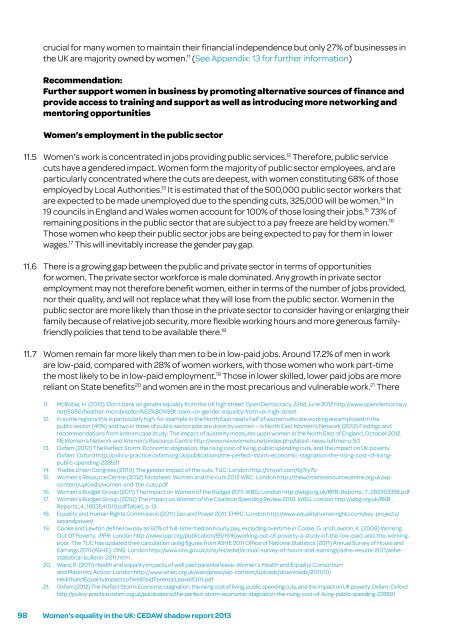Women’s equality in the UK – A health check
Women’s equality in the UK – A health check
Women’s equality in the UK – A health check
Create successful ePaper yourself
Turn your PDF publications into a flip-book with our unique Google optimized e-Paper software.
11.5<br />
11.6<br />
11.7<br />
crucial for many women to ma<strong>in</strong>ta<strong>in</strong> <strong>the</strong>ir f<strong>in</strong>ancial <strong>in</strong>dependence but only 27% of bus<strong>in</strong>esses <strong>in</strong><br />
<strong>the</strong> <strong>UK</strong> are majority owned by women. 11 (See Appendix: 13 for fur<strong>the</strong>r <strong>in</strong>formation)<br />
Recommendation:<br />
Fur<strong>the</strong>r support women <strong>in</strong> bus<strong>in</strong>ess by promot<strong>in</strong>g alternative sources of f<strong>in</strong>ance and<br />
provide access to tra<strong>in</strong><strong>in</strong>g and support as well as <strong>in</strong>troduc<strong>in</strong>g more network<strong>in</strong>g and<br />
mentor<strong>in</strong>g opportunities<br />
<strong>Women’s</strong> employment <strong>in</strong> <strong>the</strong> public sector<br />
<strong>Women’s</strong> work is concentrated <strong>in</strong> jobs provid<strong>in</strong>g public services. 12 Therefore, public service<br />
cuts have a gendered impact. Women form <strong>the</strong> majority of public sector employees, and are<br />
particularly concentrated where <strong>the</strong> cuts are deepest, with women constitut<strong>in</strong>g 68% of those<br />
employed by Local Authorities. 13 It is estimated that of <strong>the</strong> 500,000 public sector workers that<br />
are expected to be made unemployed due to <strong>the</strong> spend<strong>in</strong>g cuts, 325,000 will be women. 14 In<br />
19 councils <strong>in</strong> England and Wales women account for 100% of those los<strong>in</strong>g <strong>the</strong>ir jobs. 15 73% of<br />
rema<strong>in</strong><strong>in</strong>g positions <strong>in</strong> <strong>the</strong> public sector that are subject to a pay freeze are held by women. 16<br />
Those women who keep <strong>the</strong>ir public sector jobs are be<strong>in</strong>g expected to pay for <strong>the</strong>m <strong>in</strong> lower<br />
wages. 17 This will <strong>in</strong>evitably <strong>in</strong>crease <strong>the</strong> gender pay gap.<br />
There is a grow<strong>in</strong>g gap between <strong>the</strong> public and private sector <strong>in</strong> terms of opportunities<br />
for women. The private sector workforce is male dom<strong>in</strong>ated. Any growth <strong>in</strong> private sector<br />
employment may not <strong>the</strong>refore benefit women, ei<strong>the</strong>r <strong>in</strong> terms of <strong>the</strong> number of jobs provided,<br />
nor <strong>the</strong>ir quality, and will not replace what <strong>the</strong>y will lose from <strong>the</strong> public sector. Women <strong>in</strong> <strong>the</strong><br />
public sector are more likely than those <strong>in</strong> <strong>the</strong> private sector to consider hav<strong>in</strong>g or enlarg<strong>in</strong>g <strong>the</strong>ir<br />
family because of relative job security, more flexible work<strong>in</strong>g hours and more generous familyfriendly<br />
policies that tend to be available <strong>the</strong>re. 18<br />
Women rema<strong>in</strong> far more likely than men to be <strong>in</strong> low-paid jobs. Around 17.2% of men <strong>in</strong> work<br />
are low-paid, compared with 28% of women workers, with those women who work part-time<br />
<strong>the</strong> most likely to be <strong>in</strong> low-paid employment. 19 Those <strong>in</strong> lower skilled, lower paid jobs are more<br />
reliant on State benefits 20 and women are <strong>in</strong> <strong>the</strong> most precarious and vulnerable work. 21 There<br />
11. McRobie, H. (2012) ‘Don’t bank on gender <strong>equality</strong> from <strong>the</strong> <strong>UK</strong> high street’ Open Democracy, 22nd June 2012 http://www.opendemocracy.<br />
net/5050/hea<strong>the</strong>r-mcrobie/don%E2%80%99t-bank-on-gender-<strong>equality</strong>-from-uk-high-street<br />
12. In some regions this is particularly high, for example <strong>in</strong> <strong>the</strong> North East nearly half of women who are work<strong>in</strong>g are employed <strong>in</strong> <strong>the</strong><br />
public sector (46%) and two <strong>in</strong> three of public sector jobs are done by women <strong>–</strong> <strong>in</strong> North East <strong>Women’s</strong> Network (2012) F<strong>in</strong>d<strong>in</strong>gs and<br />
recommendations from <strong>in</strong>terim case study: The impact of austerity measures upon women <strong>in</strong> <strong>the</strong> North East of England, October 2012.<br />
NE<strong>Women’s</strong> Network and <strong>Women’s</strong> Resource Centre http://www.newwomens.net/<strong>in</strong>dex.php/latest-news-leftmenu-50<br />
13. Oxfam (2012) The Perfect Storm: Economic stagnation, <strong>the</strong> ris<strong>in</strong>g cost of liv<strong>in</strong>g, public spend<strong>in</strong>g cuts, and <strong>the</strong> impact on <strong>UK</strong> poverty.<br />
Oxfam: Oxford http://policy-practice.oxfam.org.uk/publications/<strong>the</strong>-perfect-storm-economic-stagnation-<strong>the</strong>-ris<strong>in</strong>g-cost-of-liv<strong>in</strong>gpublic-spend<strong>in</strong>g-228591<br />
14. Trades Union Congress (2010) The gender impact of <strong>the</strong> cuts. TUC: London http://t<strong>in</strong>yurl.com/6j7ry7b<br />
15. <strong>Women’s</strong> Resource Centre (2012) Factsheet: Women and <strong>the</strong> cuts 2012 WRC: London http://<strong>the</strong>womensresourcecentre.org.uk/wpcontent/uploads/women-and-<strong>the</strong>-cuts.pdf<br />
16. <strong>Women’s</strong> Budget Group (2011) The Impact on Women of <strong>the</strong> Budget 2011. WBG: London http://wbg.org.uk/RRB_Reports_7_282363355.pdf<br />
17. <strong>Women’s</strong> Budget Group (2010) The Impact on Women of <strong>the</strong> Coalition Spend<strong>in</strong>g Review 2010. WBG: London http://wbg.org.uk/RRB_<br />
Reports_4_1653541019.pdfTable1, p. 13.<br />
18. Equality and Human Rights Commission (2011) Sex and Power 2011. EHRC: London http://www.<strong>equality</strong>humanrights.com/key-projects/<br />
sexandpower/<br />
19. Cooke and Lawton def<strong>in</strong>e low pay as 60% of full-time median hourly pay, exclud<strong>in</strong>g overtime <strong>in</strong> Cooke, G. and Lawton, K. (2008) Work<strong>in</strong>g<br />
Out Of Poverty. IPPR: London http://www.ippr.org/publication/55/1616/work<strong>in</strong>g-out-of-poverty-a-study-of-<strong>the</strong>-low-paid-and-<strong>the</strong>-work<strong>in</strong>gpoor.<br />
The TUC has updated <strong>the</strong>ir calculation us<strong>in</strong>g figures from ASHE 2011 Office of National Statistics (2011) Annual Survey of Hours and<br />
Earn<strong>in</strong>gs 2011 (ASHE). ONS: London http://www.ons.gov.uk/ons/rel/ashe/annual-survey-of-hours-and-earn<strong>in</strong>gs/ashe-results-2011/ashestatistical-bullet<strong>in</strong>-2011.html<br />
.<br />
20. Ward, R. (2011) Health and <strong>equality</strong> impacts of well paid parental leave. <strong>Women’s</strong> Health and Equality Consortium<br />
and Maternity Action: London http://www.whec.org.uk/wordpress/wp-content/uploads/downloads/2011/10/<br />
HealthandEqualityImpactsofWellPaidParentalLeave20111.pdf<br />
21. Oxfam (2012) The Perfect Storm: Economic stagnation, <strong>the</strong> ris<strong>in</strong>g cost of liv<strong>in</strong>g, public spend<strong>in</strong>g cuts, and <strong>the</strong> impact on <strong>UK</strong> poverty. Oxfam: Oxford<br />
http://policy-practice.oxfam.org.uk/publications/<strong>the</strong>-perfect-storm-economic-stagnation-<strong>the</strong>-ris<strong>in</strong>g-cost-of-liv<strong>in</strong>g-public-spend<strong>in</strong>g-228591<br />
98 <strong>Women’s</strong> <strong>equality</strong> <strong>in</strong> <strong>the</strong> <strong>UK</strong>: CEDAW shadow report 2013


